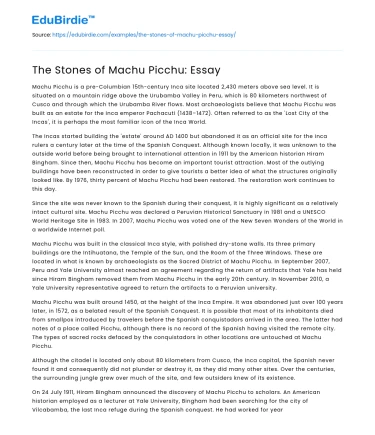Machu Picchu is a pre-Columbian 15th-century Inca site located 2,430 meters above sea level. It is situated on a mountain ridge above the Urubamba Valley in Peru, which is 80 kilometers northwest of Cusco and through which the Urubamba River flows. Most archaeologists believe that Machu Picchu was built as an estate for the Inca emperor Pachacuti (1438–1472). Often referred to as the 'Lost City of the Incas', it is perhaps the most familiar icon of the Inca World.
The Incas started building the 'estate' around AD 1400 but abandoned it as an official site for the Inca rulers a century later at the time of the Spanish Conquest. Although known locally, it was unknown to the outside world before being brought to international attention in 1911 by the American historian Hiram Bingham. Since then, Machu Picchu has become an important tourist attraction. Most of the outlying buildings have been reconstructed in order to give tourists a better idea of what the structures originally looked like. By 1976, thirty percent of Machu Picchu had been restored. The restoration work continues to this day.
Save your time!
We can take care of your essay
- Proper editing and formatting
- Free revision, title page, and bibliography
- Flexible prices and money-back guarantee
Since the site was never known to the Spanish during their conquest, it is highly significant as a relatively intact cultural site. Machu Picchu was declared a Peruvian Historical Sanctuary in 1981 and a UNESCO World Heritage Site in 1983. In 2007, Machu Picchu was voted one of the New Seven Wonders of the World in a worldwide Internet poll.
Machu Picchu was built in the classical Inca style, with polished dry-stone walls. Its three primary buildings are the Intihuatana, the Temple of the Sun, and the Room of the Three Windows. These are located in what is known by archaeologists as the Sacred District of Machu Picchu. In September 2007, Peru and Yale University almost reached an agreement regarding the return of artifacts that Yale has held since Hiram Bingham removed them from Machu Picchu in the early 20th century. In November 2010, a Yale University representative agreed to return the artifacts to a Peruvian university.
Machu Picchu was built around 1450, at the height of the Inca Empire. It was abandoned just over 100 years later, in 1572, as a belated result of the Spanish Conquest. It is possible that most of its inhabitants died from smallpox introduced by travelers before the Spanish conquistadors arrived in the area. The latter had notes of a place called Picchu, although there is no record of the Spanish having visited the remote city. The types of sacred rocks defaced by the conquistadors in other locations are untouched at Machu Picchu.
Although the citadel is located only about 80 kilometers from Cusco, the Inca capital, the Spanish never found it and consequently did not plunder or destroy it, as they did many other sites. Over the centuries, the surrounding jungle grew over much of the site, and few outsiders knew of its existence.
On 24 July 1911, Hiram Bingham announced the discovery of Machu Picchu to scholars. An American historian employed as a lecturer at Yale University, Bingham had been searching for the city of Vilcabamba, the last Inca refuge during the Spanish conquest. He had worked for years in previous trips and explorations around the zone. Pablito Alvarez, a local 11-year-old Quechua boy, led Bingham up to Machu Picchu. Some Quechuas lived in the original structures at Machu Picchu.






 Stuck on your essay?
Stuck on your essay?

